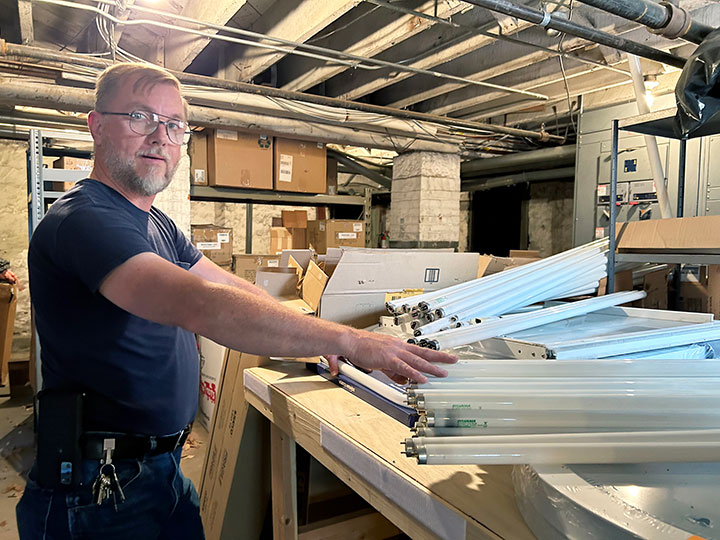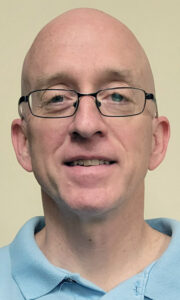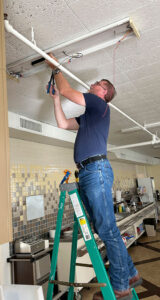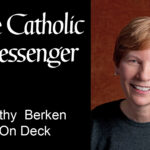
Rich Hatfield, facilities manager for the Diocese of Davenport, shows incandescent lights that were changed out for LED bulbs at St. Vincent Center in Davenport this fall.
By Barb Arland-Fye
The Catholic Messenger
DAVENPORT — After replacing 1,400 incandescent light bulbs with 1,400 energy efficient LEDs at diocesan headquarters, Facilities Manager Rich Hatfield and co-worker David Houdyshell look forward to not replacing another light bulb for at least 10 years.
That painstaking job, completed this fall, required hours on ladders, removing light ballasts and rewiring the fixtures for LED lights. It represents one component of the Diocese of Davenport’s Laudato Si’ Action Platform plan, introduced a year ago, Oct. 4, on the memorial of St. Francis of Assisi.
Pope Francis initiated the Laudato Si’ Action Platform two years ago to encourage Catholics worldwide to respond to the ecological crisis that is harming the planet and threatening people’s lives and livelihoods. “Working together,” he said, of the multifaceted, seven-year platform, “we will be able to create the future we want: a more inclusive, fraternal, peaceful and sustainable world” (laudatosiactionplatform.org).

In the Davenport Diocese, the Laudato Si’ Action Platform plan (LSAP) serves as a springboard for a decades-long commitment that began with an energy audit of the 124-year St. Vincent Center (diocesan chancery). “Our goal is for chancery operations to be carbon neutral by 2050,” said Deacon Kent Ferris, diocesan director of the Social Action Office, who oversees the LSAP in collaboration with other diocesan department leaders. “The Church is challenging us to be leaders in society when it comes to caring for Creation.”
Carbon neutral means “having or resulting in no addition of carbon dioxide to the atmosphere … counterbalancing the emission of carbon dioxide with carbon offsets” (Merriam-Webster). Carbon offsets refer to such actions as “the planting of trees or carbon sequestration that compensates for the emission of carbon dioxide or other greenhouse gases to the atmosphere.” The diocese’s ultimate goal is to achieve “net zero,” which means no emission of carbon and, thus, no need to offset emissions.
Diocesan leaders released a progress report on mid-project goals this fall. The report begins with the results of an energy audit of the chancery, made possible through financial support from the Catholic Climate Covenant. The Verdis Group, which completed the audit earlier this year, calculated the Chancery’s greenhouse gas emissions for 2021 at 134 metric tons (CO2 Equivalent). “This is equivalent to the energy for 17 homes for a year or approximately 29 cars driven for a year,” the report states.
Verdis Group consultants recommended use of renewable energy for heating, cooling and electricity “to reduce our carbon emissions,” Deacon Ferris said. The consultants also “highly recommended developing mid-project goals to help track and strengthen commitment to the project.”
Here is a summary of mid-project goals:
- Chancery vehicles. The Chancery will move from gasoline-powered to renewable-energy vehicles. At present, the diocese has one hybrid vehicle in its fleet of five vehicles. Diocesan leaders anticipate the move to more hybrid vehicles, followed by fully electric vehicles when the necessary public infrastructure is in place to safely reach and return from all locations in the diocese, Hatfield said. The goal: 100% hybrid vehicles by 2035 and 100% fully electric vehicles by 2040. Hatfield is following reports about the evolving technology for electric vehicles, the batteries that power them and battery-charging stations. “A study of the next generation of batteries is being funded by the Big 3 automakers,” he said.
- Heating and cooling. At present, a combination of steam boiler, window-mounted air-conditioning units, central heating and air-conditioning (using both electricity and natural gas) heat and cool the chancery. Central control of thermostats has replaced individual control by diocesan employees, resulting in cost savings, Hatfield said. The temperature is set at 68 degrees F in the winter and 72 degrees F in the summer. Employees working from home on Fridays also saves energy costs.
Exploration of alternative sources for energy and heating/cooling are under way, along with consultation and collaboration with “our Catholic neighbors,” Deacon Ferris said, referring to the Congregation of the Humility of Mary (CHM), Assumption High School (AHS) and St. Ambrose University (SAU), all within a mile of the chancery.
Verdis Group consultants suggest two capital projects: installation of a solar array and of a ground source heat pump (geothermal heating). One small solar array, providing 7 metric tons of carbon offset, would cost approximately $40,000 and require a 16-year payback period. The second, larger proposed array would require use of several building rooftops for 20 metric tons of carbon offset, with an estimated cost of $140,000 and an 18-year payback.
The estimated cost to convert to a ground source heat pump is significant — an estimated $2 million-$2.5 million, Hatfield said. Many factors complicate the project, including the age of the Chancery (a former orphanage), and the need to increase the electrical load to handle more power. “There’s a huge difference between what needs to be done and how to get there.” Planning for these major projects in the diocesan budget is essential, Deacon Ferris, Hatfield and other diocesan department leaders say.
Collaboration is also crucial. Earlier this fall, chancery staff leaders from different departments met with representatives of SAU, CHM and AHS to share the diocesan energy audit report and to discuss ideas for possible collaboration on renewable energy projects. Three of the four entities have or plan to undertake energy audits. “Sharing information regarding funding options, reputable vendors or even the possibility of undertaking mutual projects creates synergy that would be absent if each undertook projects in isolation,” Deacon Ferris said.
- Lighting. Installation of LED lights in the Chancery reduces energy usage (14 watts per LED vs. 32 watts per incandescent) and generated a rebate from MidAmerican Energy Company, lowering the purchase cost of LED lights significantly, Hatfield said. “I’m super excited,” he said of completing the project and seeing the diocese reaping the benefits.
Update on other LSAP elements. Deacon Ferris appreciates parishes’ enthusiastic participation in the month-long annual Season of Creation observance this fall. Prayer gatherings, youth and adult faith formation sessions and movie screenings were among the program offerings this year. Lay and clergy with expertise in environmental issues also helped raise awareness and interest. For example, Father Bud Grant, a moral theologian and environmental ethicist at SAU, gave a presentation on “Laudate Deum,” the follow-up exhortation to Pope Francis’ encyclical, “Laudato Si.’”

Rich Hatfield, diocesan facilities manager changes wiring to install LED lighting that replaces incandescent lighting at diocesan headquarters in Davenport.
The diocese is also collaborating with people from other faith traditions and organizations, such as Interfaith Power & Light (IPL) and its Iowa affiliate, Iowa Interfaith Power & Light (Iowa IPL). Iowa IPL is drawing attention to the “profound importance of getting MidAmerican Energy to retire their many coal-fired plants much sooner than their projected 2049 date,” Deacon Ferris said. Such collaboration “strengthens the message that corporations and elected officials hear about the importance of care for Creation.” The LSAP “can also be a conversation starter with elected officials” and “may even inspire representatives to be courageous in support of the common good.”
Closing thoughts. Deacon Ferris is grateful to the chancery staff committed to undertaking LSAP and to a St. Ambrose University student, Samantha Sancern, who helped craft the LSAP during her diocesan Laudato Si’ internship. Their efforts resulted in the diocese receiving an honorable mention this year from the Catholic Climate Covenant for outstanding achievements by a Catholic institution in environmental sustainability and stewardship.
Top accolades go to Archbishop Thomas Zinkula, the Davenport Diocese’s former bishop who now leads the Dubuque Archdiocese. He “accepted the challenge to commit our diocese to the Laudato Si’ Action Plan,” Deacon Ferris said, “drawing attention to our responsibility to be in right relationship with God, our neighbor and as part of the created world.”
(Read the full report at davenportdiocese.org/laudato-si-plan)











